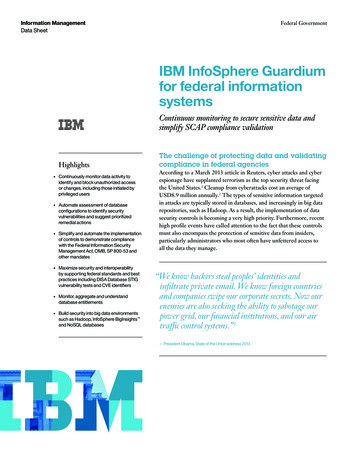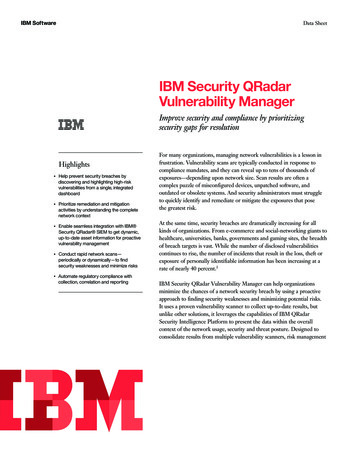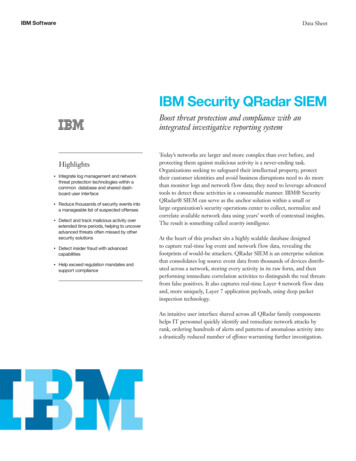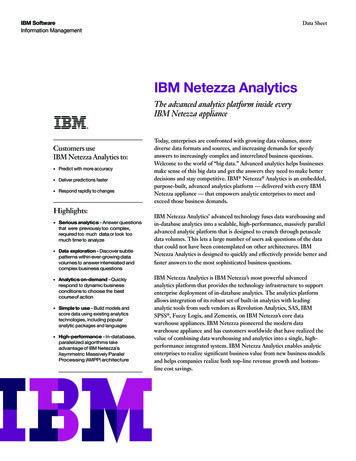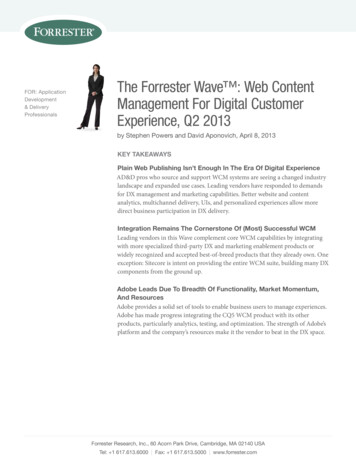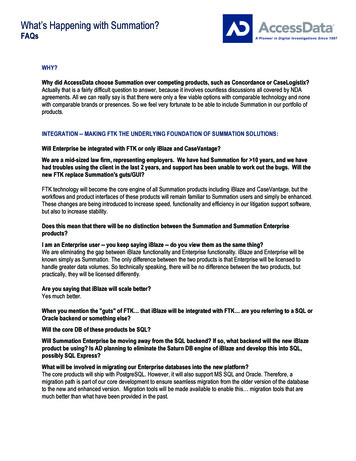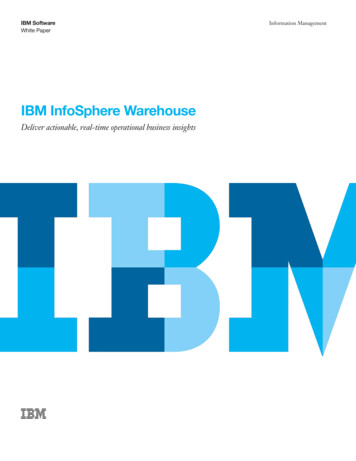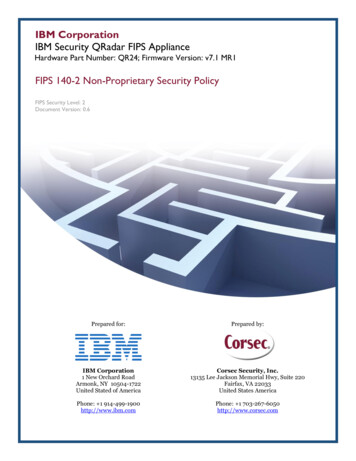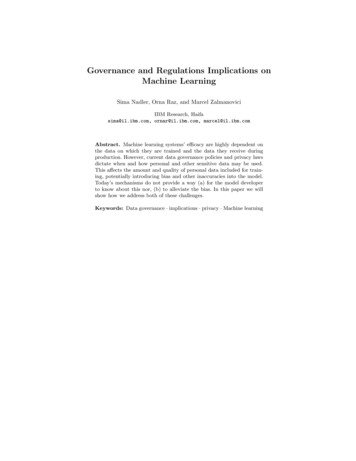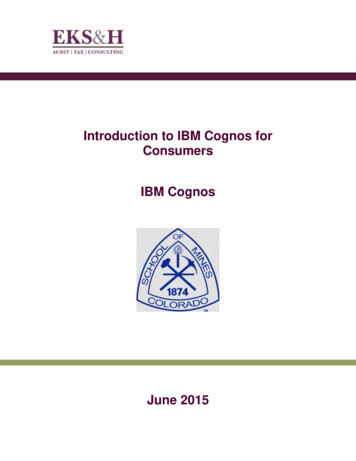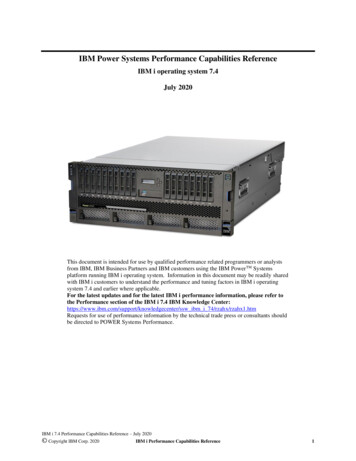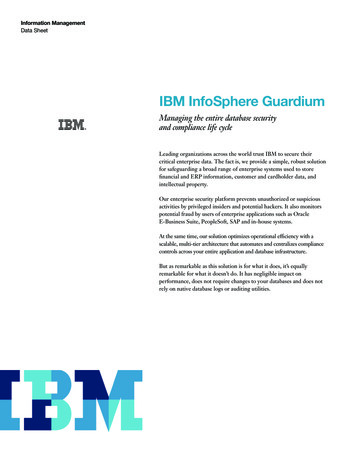
Transcription
Information ManagementData SheetIBM InfoSphere GuardiumManaging the entire database securityand compliance life cycleLeading organizations across the world trust IBM to secure theircritical enterprise data. The fact is, we provide a simple, robust solutionfor safeguarding a broad range of enterprise systems used to storefinancial and ERP information, customer and cardholder data, andintellectual property.Our enterprise security platform prevents unauthorized or suspiciousactivities by privileged insiders and potential hackers. It also monitorspotential fraud by users of enterprise applications such as OracleE-Business Suite, PeopleSoft, SAP and in-house systems.At the same time, our solution optimizes operational efficiency with ascalable, multi-tier architecture that automates and centralizes compliancecontrols across your entire application and database infrastructure.But as remarkable as this solution is for what it does, it’s equallyremarkable for what it doesn’t do. It has negligible impact onperformance, does not require changes to your databases and does notrely on native database logs or auditing utilities.
Information ManagementData SheetReal-time database security and monitoring Prevent cyberattacks Monitor and block privileged users Detect application-layer fraud Enforce change controls Real-time alerts Automated and centralized controlsAuditandReportMonitorandEnforce Control firecall IDs Discover embeddedmalware and logic bombs Sign-off management Entitlement reporting No database changesCriticalDataInfrastructure Continuously updatesecurity policies Preconfigured policies/reports Minimal performance impact SIEM integration Find and classifysensitive data Cross-DBMS audit repositoryFindandClassifyAssessandHarden Assess static andbehavioral databasevulnerabilities Configuration auditing Preconfigured testsbased on best practicesstandards (STIG, CIS, CVE)Unified Solution: Built on a single unified console and back-end data store, InfoSphere Guardium offers a family of integrated modules for managing theentire database security and compliance life cycle.The IBM InfoSphere Guardium solution addresses theentire database security and compliance life cycle with aunified web console, back-end data store and workflowautomation system, enabling you to: Find and classify sensitive data in corporate databases.Assess database vulnerabilities and configuration flaws.Ensure that configurations are locked down afterrecommended changes are implemented.Capture and examine all database transactions, includinglocal access by privileged users — for all supported platformsand protocols — with a secure, tamper-proof audit trail thatsupports separation of duties.Track activities on major file sharing platforms. 2Monitor and enforce policies for sensitive data access,privileged user actions, change control, application useractivities and security exceptions such as login failures.Automate the entire compliance auditing process —including report distribution to oversight teams, sign-offand escalat ions — with preconfigured reports for SOX,PCI Data Security Standard (DSS) and data privacy.Create a single, centralized audit repository for enterprisewide compliance reporting, performance optimization,investigations and forensics.Easily scale from safeguarding a single database toprotecting thousands of databases in distributed datacenters around the world.
Information ManagementData SheetFind and classifyAutomated vulnerability, configuration and behavioralassessmentAs organizations create and maintain an increasing volume ofdigital information, they are finding it harder and harder tolocate and classify sensitive information.The database security assessment capability of InfoSphereGuardium scans your entire database infrastructure forvulnerabilities and provides an ongoing evaluation ofyour database security posture, using both real-time andhistorical data.Locating and classifying informationLocating and classifying sensitive information is especiallychallenging for organizations that have experiencedmergers and acquisitions or for environments where existingsystems have outlasted their original developers. Even inthe best of cases, ongoing changes to application anddatabase structures — required to support new businessrequirements — can easily invalidate static security policiesand leave sensitive data unknown and unprotected.It provides a comprehensive library of preconfigured testsbased on industry best practices (CVE, CIS, STIG), alongwith platform-specific vulnerabilities, which are updatedregularly by the InfoSphere Guardium Knowledge Baseservice. You can also define custom tests to match specificrequirements. The assessment module flags compliancerelated vulnerabilities such as unauthorized access to reservedOracle E-Business Suite and SAP tables for compliance withSOX and PCI DSS.Organizations find it particularly difficult to: Map out all database servers containing sensitiveinformation and understand how it is being accessed fromall sources (line-of-business applications, batch processes,ad hoc queries, application developers, administratorsand others).Secure information and manage risk when the sensitivity ofstored information is unknown.Ensure compliance when it isn’t clear which information issubject to the terms of particular regulations.Assessments are grouped into two broad categories: Automatically locate, classify and secure sensitiveinformationWith InfoSphere Guardium, you use database auto-discoveryand information classification to identify where confidentialdata is stored and then use customizable classification labels toautomate enforcement of security policies that apply toparticular classes of sensitive objects. These policies ensurethat sensitive information is only viewed and changed byauthorized users. Sensitive data discovery can also bescheduled to execute regularly to prevent the introduction ofrogue servers and ensure that no critical information is“forgotten.”Vulnerability and configuration tests check forvulnerabilities such as missing patches, misconfiguredprivileges and default accounts.Behavioral tests identify vulnerabilities based on howdatabases are being accessed and manipulated — such asan excessive number of login failures, clients executingadministrative commands or after-hours login — bymonitoring all database traffic in real time.In addition to producing detailed reports, along withsupporting data, the assessment module generates a securityhealth report card. The report card not only includes weightedmetrics based on best practices and industry standard referencenumbers, but it also recommends concrete action plans tostrengthen database security.Configuration lock-down and change trackingAfter you have implemented the actions recommendedin the vulnerability assessment, you can establish a secureconfiguration baseline. The InfoSphere GuardiumConfiguration Audit System can monitor changes tothis baseline and make sure they are not made outside ofyour authorized change control policies and processes.Assess and hardenDatabase environments are highly dynamic, with changes inaccounts, configurations and patches occurring regularly.Most organizations lack the skilled resources to reviewchanges systematically to determine if they have introducedsecurity gaps.3
Information ManagementData SheetMonitor and enforceinclude real-time security alerts (SMTP, SNMP, Syslog);software blocking; full logging; user quarantines; and customactions such as shutting down VPN ports and coordinatingwith perimeter IDS/IPS systems.Escalating threats to sensitive data, along with growingcompliance mandates, are driving organizations to seekeffective means of monitoring database activities enterprisewide and preventing unauthorized activities in real time.Tracking and resolving security incidentsCompliance regulations require organizations to demonstratethat all incidents are recorded, analyzed, resolved in a timelymanner and reported to management. InfoSphere Guardiumprovides a business user interface and workflow automationfor resolving security incidents, along with a dashboard fortracking key metrics such as number of open incidents,severity levels and length of time incidents have been open.Monitor and enforce policies for database security andchange controlInfoSphere Guardium provides granular, real-time policies toprevent unauthorized or suspicious actions by privilegeddatabase accounts and attacks from rogue users or outsiders.You can also identify application users that make unauthorizedchanges to databases with multi-tier applications that accessdatabases from a common service account, such as OracleE-Business Suite, PeopleSoft, Siebel, SAP, IBM Cognos software and custom systems built on application servers suchas Oracle WebLogic, Oracle AS and those in the IBMWebSphere family.Audit and reportGrowing volumes of data, often physically distributedthroughout an enterprise, are making it increasingly difficultfor organizations to capture and analyze the detailed audittrails required for validating compliance.The solution can be managed by information securitypersonnel without involving database administrators (DBAs).You can also define granular access policies that restrict accessto specific tables based on operating system login, IP or MACaddress, source application, time of day, network protocol andtype of SQL command.Capturing a granular audit trailInfoSphere Guardium creates a continuous, fine-grained trailof database activities that is contextually analyzed and filteredin real time to implement controls and produce the specificinformation required by auditors.Continuous contextual analysis of all database trafficThe resulting reports demonstrate compliance by making itpossible to view database activities in detail, such as loginfailures, escalation of privileges, schema changes, accessduring off-hours or from unauthorized applications and accessto sensitive tables. For example, the system monitors:InfoSphere Guardium continuously monitors all databaseoperations in real time, using linguistic analysis to detectunauthorized actions based on detailed contextualinformation — the “who, what, where, when and how” ofeach SQL transaction. This contextual approach minimizesfalse positives and negatives while providing a significantlevel of control, unlike traditional approaches that onlylook for predefined patterns or signatures. Baselining to detect anomalous behavior and automatepolicy definition By creating a baseline and identifying normal businessprocesses and what appear to be abnormal activities, thesystem automatically suggests policies you can use to preventattacks such as SQL injection. Intuitive menus make it easyto add custom policies. Proactive, real-time security InfoSphere Guardium provides real-time controls forresponding to unauthorized or anomalous behaviors beforethey can do significant harm. Policy-based actions can 4Security exceptions such as SQL errorsCommands such as CREATE/DROP/ALTER that changestructures, which are particularly important for datagovernance regulations such as SOXSELECT/READ/OPEN commands, which are particularlyimportant for data privacy regulations such as PCI DSSData manipulation commands (for example, INSERT,UPDATE, DELETE), including bind variablesData Control Language commands that control accounts,roles and permissions (GRANT, REVOKE)Procedural languages supported by each DBMS platformsuch as PL/SQL (Oracle) and SQL/PL (IBM)XML executed by the databaseChanges to Microsoft SharePoint objects
Information ManagementData SheetEnterprise-wide scalability with minimized costsInfoSphere Guardium scales easily, using built-in automation and integration functions to reduce operational costs while adapting tochanges in audit requirements and the environment. Irrespective of system size, InfoSphere Guardium simplifies operations, providing: A single solution. Comprehensive platform support and broad functionality, including proactive protection, enables deployment ofa single solution enterprise wide. Noninvasive design. No changes to existing database, application or network configurations are required and there is no reliance onnative logging, minimizing performance impact. Investment protection. As the number of servers to monitor increases, you can simply add capacity to preserve existing InfoSphereGuardium purchases and configuration investments such as policies and compliance workflow. Simple administration. A single interface is used to manage appliances and probes, including configuration, user management andsoftware updates. Probes are updated without reboot. Enterprise-wide analysis and reporting. Audit information — from multiple database platforms and collectors — is automaticallynormalized and aggregated into a single, secure, centralized audit repository with advanced reporting and analytics Task automation. Capabilities that eliminate manual tasks, such as integrated compliance workflow automation, extensive API supportfor script based automation, configuration auditing templates, automated information sharing between functions and more, are includedin the system. Deployment flexibility. Delivery as preconfigured appliances, in hardware and software form, supports a range of cost reductionstrategies. Monitoring with lightweight host-based probes, over the network, or any combination is supported, maximizing visibility. Infrastructure integration. Automated interaction with systems, including LDAP, administrative databases, email, change ticketingand Syslog, eliminates manual exchanges of security information.z/OSS-TAP for DB2S-TAP for IMSS-TAP for VSAMAsia-PacData CentersCollectorS-TAPEuropean DataCentersCollectorCollectorData-Level Access ControlAmericas ntral Policy Managerand Audit RepositoryOracle, SQL Server, DB2(distributed and mainframe),Informix, Sybase, MySQL,Teradata, Netezza, PostgreSQLSharePoint Servers5A scalable multi-tier architecturesupports large and smallenvironments, with centralizedaggregation and normalizationof audit data and centralizedmanagement of security policiesenterprise wide. S-TAPs arelightweight, host-based probesthat are able to monitor databasetraffic, including local access byprivileged users, and relay it toInfoSphere Guardium collectorappliances for analysis andreporting. Collector appliancesgather monitored data fromS-TAPs or by connecting directlyto SPAN ports in networkswitches. Aggregatorsautomatically assemble auditdata from multiple collectorappliances. Multiple tiers ofaggregators can be configuredfor greater flexibility andscalability. Implemented as anextension to S-TAP, theInfoSphere Guardium Data-LevelAccess Control strengthenssecurity and enforces separationof duties by blocking DBAs fromcreating new database accounts,elevating privileges for existingaccounts and more.
Information ManagementData SheetBest-in-class reportingBroad platform supportThe InfoSphere Guardium solution includes more than 150preconfigured policies and reports based on best practices andour experience working with Global 1000 companies, majorauditors and assessors around the world. These reports helpaddress regulatory requirements such as SOX, PCI DSS anddata privacy laws, and they help streamline data governanceand data privacy initiatives.All major DBMS platforms and protocols running on majoroperating systems, along with a growing range of file anddocument-sharing environments, are supported.In addition to prepackaged report templates, InfoSphereGuardium provides a graphical drag-and-drop interface foreasily building new reports or modifying existing reports.Reports can be automatically sent to users in PDF format (asemail attachments) or as links to HTML pages. They can alsobe viewed online in the web console or exported to SIEM andother systems in standard formats.Compliance workflow automationThe InfoSphere Guardium Compliance WorkflowAutomation application streamlines the entire complianceworkflow process, helping automate audit report generation,distribution to key stakeholders, electronic sign-off andescalations. Workflow processes are completely usercustomizable; specific audit items can be individually routedand tracked through sign-off.Unified solution for heterogeneousenvironmentsMost organizations have databases from a variety of vendorsdeployed on a range of operating systems, making it difficultto enforce uniform security policies and gather consistentaudit information enterprise-wide. Heterogeneousenvironments can also result in taking a silo approach tosecurity and compliance activities, driving up operational costsand consuming scarce resources.Supported PlatformSupported VersionsOracle Database8i, 9i, 10g (r1, r2), 11g, 11gr2Oracle Database (ASO, SSL)9i, 10g (r1, r2), 11gMicrosoft SQL Server2000, 2005, 2008Microsoft SharePoint2007, 2010IBM DB2 (Linux, UNIX,Linux for System z)9.1, 9.5, 9.7IBM DB2 (Windows)9.1, 9.5, 9.7IBM DB2 pureScale 9.8IBM DB2 for z/OS8.1, 9.1, 10.1IBM IMS 9, 10, 11, 12IBM VSAMSee OS support tableIBM DB2 for IBM iSeries V5R2, V5R3, V5R4, V6R1IBM Informix 7, 9, 10, 11,11.50, 11.7Sun MySQL and MySQL Cluster4.1, 5.0, 5.1Sybase ASE12, 15, 15.5Sybase IQ12.6, 12.7, 15IBM Netezza NPS 4.5, 4.6, 4.6.8, 5.0, 6.0PostgreSQL8,9Teradata6.X, 12, 13, 13.10FTP6
Information ManagementData SheetHost-based monitoringApplication monitoringS-TAPs are lightweight software probes that monitor bothnetwork and local database protocols (for example, sharedmemory, named pipes) at the operating system level of thedatabase server. S-TAPs minimize any effect on serverperformance by relaying all traffic to separate InfoSphereGuardium appliances for real-time analysis and reporting,rather than relying on the database itself to process and storelog data. S-TAPs are often preferred because they eliminatethe need for dedicated hardware appliances in remote locationsor available SPAN ports in your data center.InfoSphere Guardium identifies potential fraud by trackingactivities of users who access critical tables with multi-tierenterprise applications rather than direct access to thedatabase. This is required because enterprise applicationstypically use an optimization mechanism called “connectionpooling.” In a pooled environment, all user traffic isaggregated in a few database connections that are identifiedonly by a generic application account name, thereby maskingthe user identities. InfoSphere Guardium supports application monitoring for all major off-the-shelf enterpriseapplications. Support for other applications, includingin-house applications, is provided either by monitoringtransactions at the application server level or by interfacingthem to the InfoSphere Guardium universal feed. IBMprovides documentation of the universal feed protocol, whichenables organizations to implement an interface to supportany subset of the monitoring and protective featuressupported by InfoSphere Guardium appropriate for theirunique environments.OS TypeVersion32-bit and 64-bitIBM AIX 5.2, 5.3,Both6.1, 7.164-bitHP-UX11.11, 11.23, 11.31BothRed Hat EnterpriseLinux3, 4, 5BothRed Hat EnterpriseLinux for System z5.4SUSE Enterprise Linux9, 10, 11SUSE Enterprise Linuxfor System z9, 10, 11Solaris — SPARC8, 9, 10, 11BothSolaris — Intel/AMD10Both Oracle Application Server (AS)1164-bit JBoss Enterprise ApplicationPlatformTru645.1A, 5.1B64-bitWindows2000, 2003, 2008BothiSeriesIBM i5/OS *z/OS1.10 (5694-A01) orlaterSupported EnterpriseApplications Oracle E-Business Suite PeopleSoft Siebel SAPBoth Cognos Business Objects WebIntelligenceSupported ApplicationServer Platforms* Supports network activity monitoring, local activity support withEnterprise Integrator7 IBM WebSphere BEA WebLogic
About IBM InfoSphere GuardiumInfoSphere Guardium is part of the IBM InfoSphereintegrated platform for defining, integrating, protecting andmanaging trusted
Automated vulnerability, configuration and behavioral assessment The database security assessment capability of InfoSphere Guardium scans your entire database infrastructure for vulnerabilities and p
